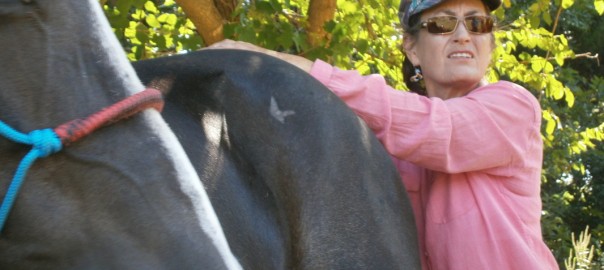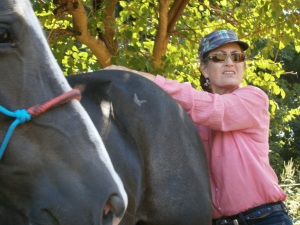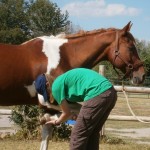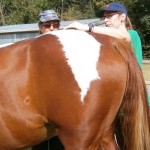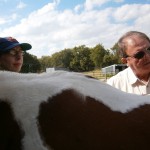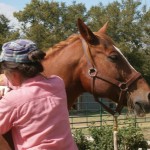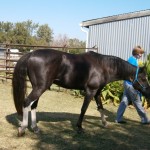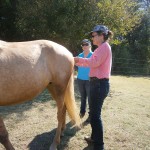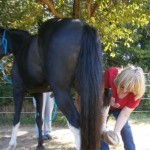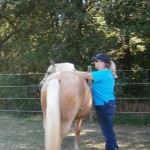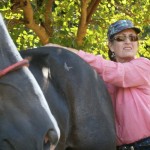Last weekend I conducted a three-hour tutorial on equine bodywork on Friday before the Spirit Horse Liberty Foundation Clinic in Jones, Oklahoma. Visiting and ranch horses were evaluated and students learned some skills in how to do bodywork on their own horses, with work on the hindquarters, shoulders and legs that translated to the spine. This work addresses the physical problems horses suffer. Among the students were an equine chiropractor, horse trainer and nurse who were all amazed as I have often been at the powerful effect of Equine Ortho-Bionomy.
Based on Ortho-Bionomy, the horse work is non-force, dynamic and very powerful. In this work the nerves send a message to the central nervous system which then moves it toward “self-correction.” We are working with the body’s innate ability to self-correct. One of the advantages of this work is that we can work on all facets of health, from structure , to muscles, fascia, tendons, ligaments, fluids, organs, and emotional health.
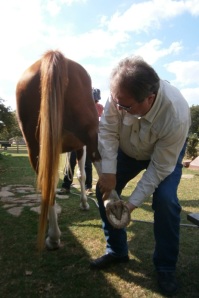
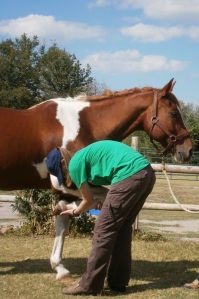
The areas of the body we addressed were the scapula, pelvis and sacrum. By addressing those areas, we also influenced specific areas of the spine and neck. Participants learned the beginnings of palpation, which takes awhile to learn – approximately six months of practice each day for half an hour. Obviously those who have studied bodywork will already have this palpation knowledge embodied. It is a matter of identifying differences in the feel of tissue, and by tissue I mean bones, which are the densest form of tissue, as well as fascia, muscles, ligaments and tendons.
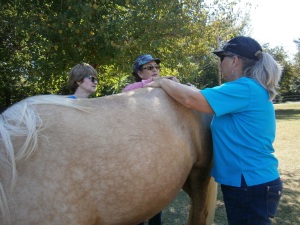
We assessed the horses general appearance and by walking them out. We could also move them to see where movement translated along the spine. What we looked for in the a self-corrective response were the following:
Muscles relaxing or changing
Increased range of motion
Difference in coat pattern, sweating, pulsing, twitching.
Sometimes while working the horse will lick and chew, or shift its weight, or sigh deeply.
In the first segment we worked with two horses with some restrictive problems such as lameness and joint irregularity. We were able to achieve more fluidity in movement for both those horses. In the second segment we worked with a horse with an over-reaching stride. As I was there for two more days, I saw and felt that his stride self-corrected and he was no longer over-reaching by Day 3, when I got on his back. This was wonderful to experience because most of the time I don’t get to experience that change first hand. We also worked with a laminitic pony on how to work on the legs when the horse can’t lift them, or the practitioner is unable to lift the leg because of physical restrictions.
Because we ride horses, we experience a lot of what they experience in our own bodies as well. We are very close to horses, if we are properly tuned in. Student work was excellent and made big differences to all the horses.
If you are interested in learning more about this work, an upcoming weekend clinic October 26-27th will be held in Santa Fe, taught by EPR (Equine Positional Release) founder, Zarna Carter:
EPR II offered by instructor Zarna Carter
OrthoHorse Tutorials will be offered on the 2014 schedule.
Fascinating article on Ortho-Bionomy: Better than a pain pill? PostIndependent.com
Services: Bodywork (Ortho-Bionomy for people, Equine Positional Release/Equine Ortho-Bionomy): private sessions, tutorials, phone consultations, distance healing communication and gift certificates
Liberty Training: clinics, mini-clinics, workshops, private and semi-private sessions, tutorials, consultations: by appointment: 505.501.2478 or emailing susansmith@orthohorse.info
Looking forward to Fall Lessons – semi-private, private and small group sessions. Scheduling now. We have small groups and privates scheduled for Santa Fe and Corrales and El Dorado currently. Contact me for details.
Copyright (c) Susan Smith, OrthoHorse, Horses at Liberty Foundation Training



